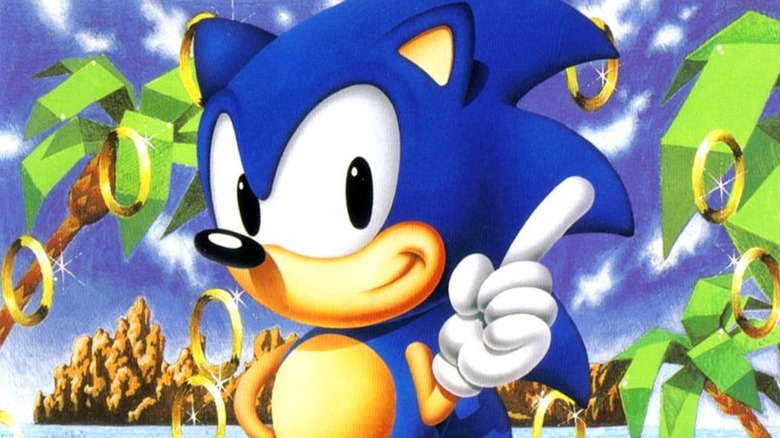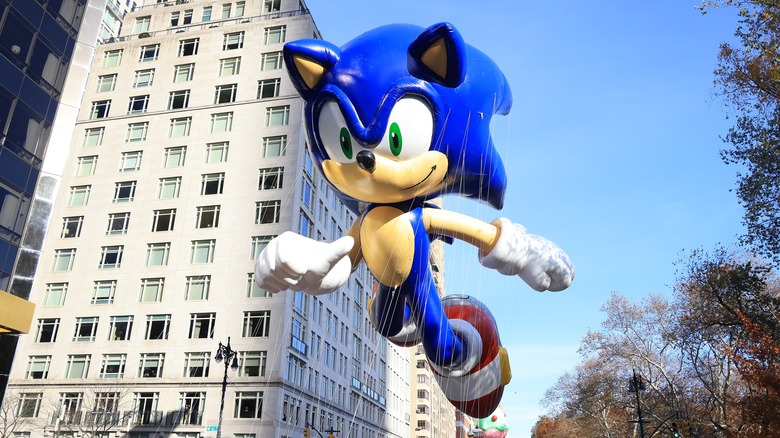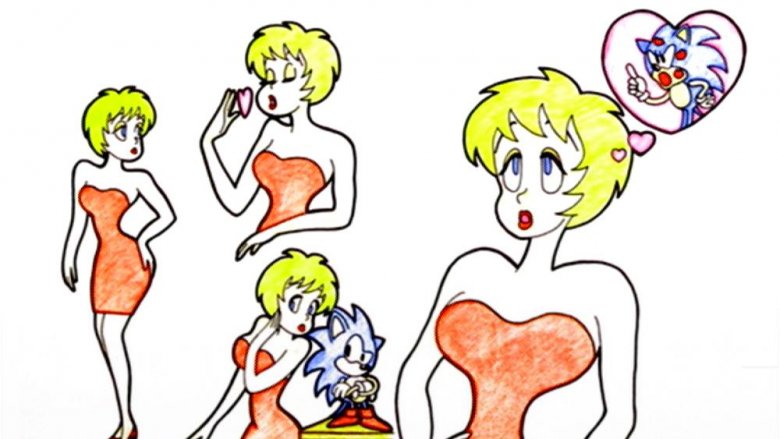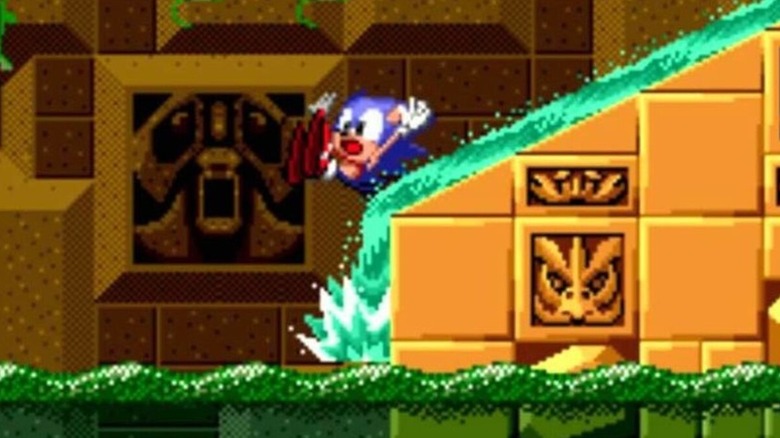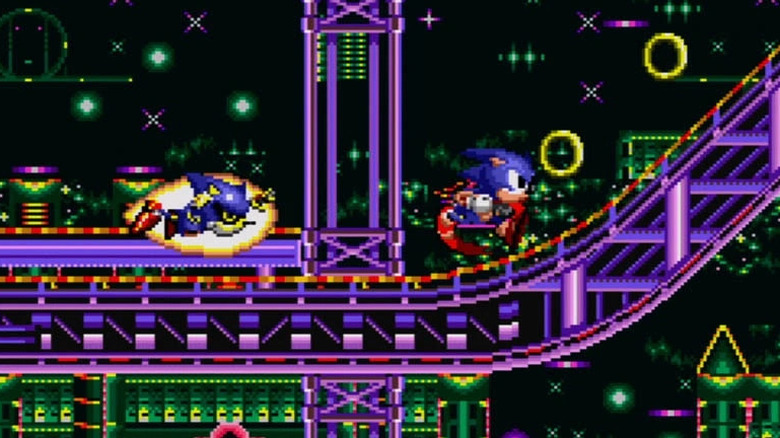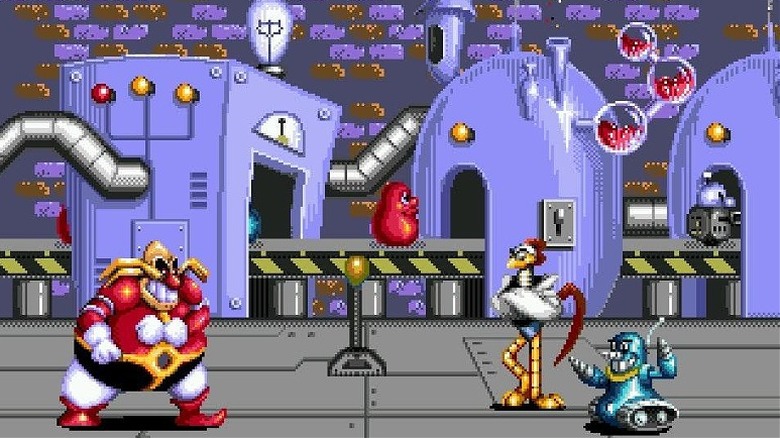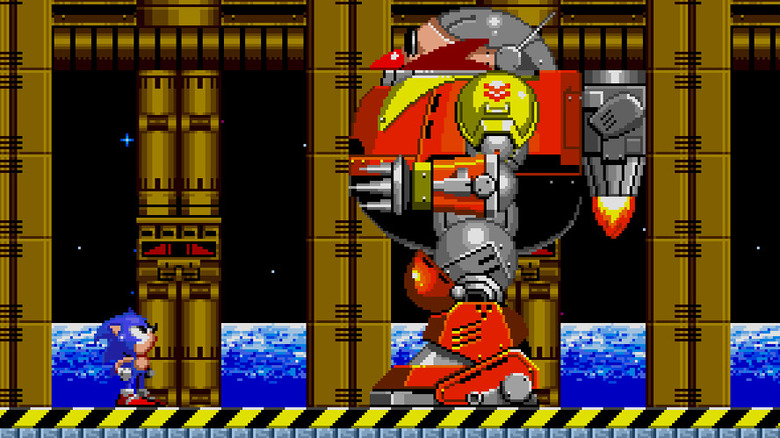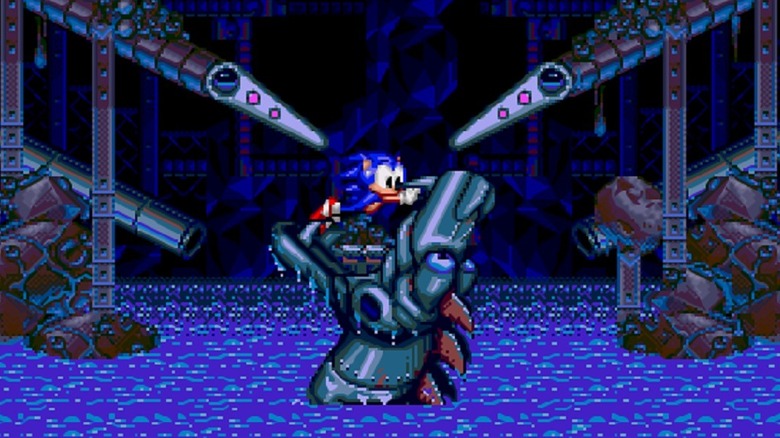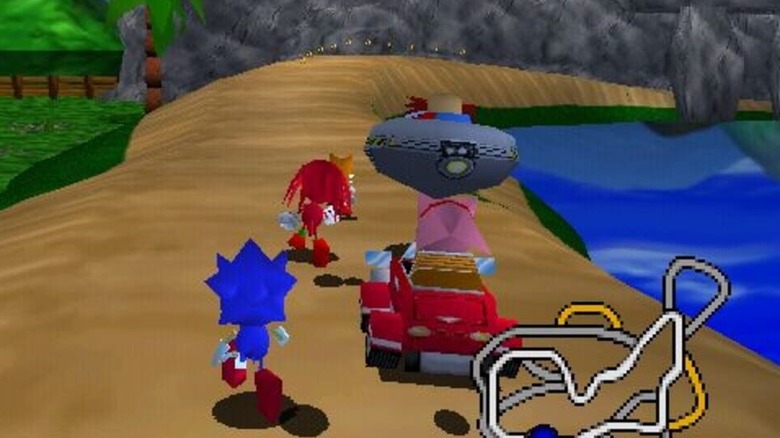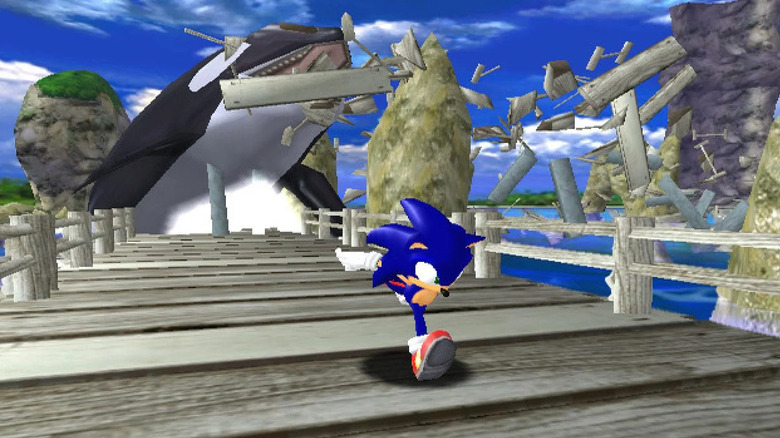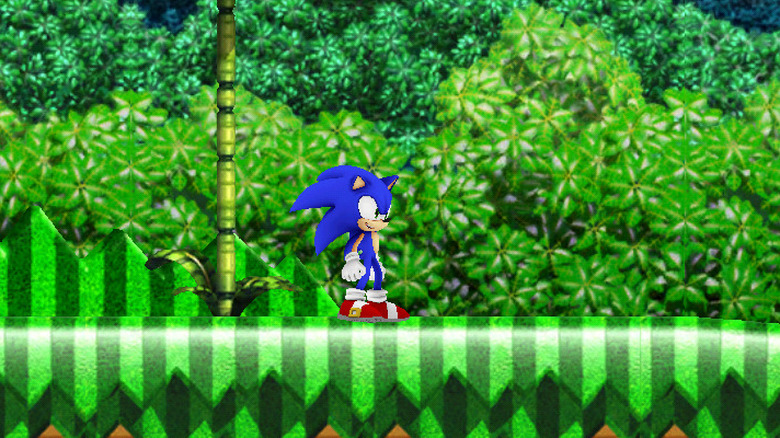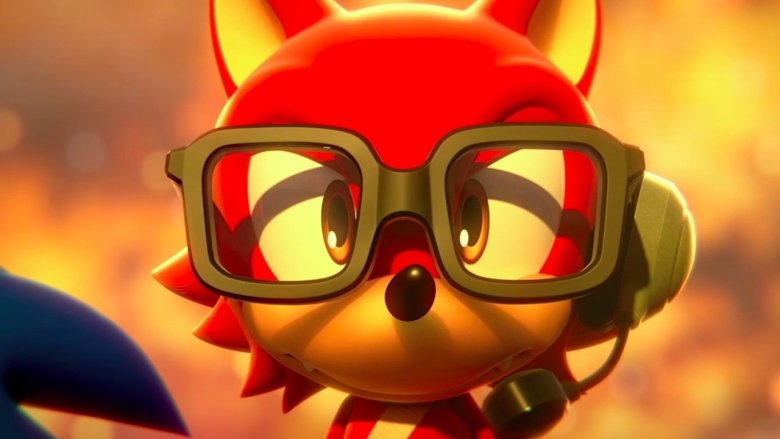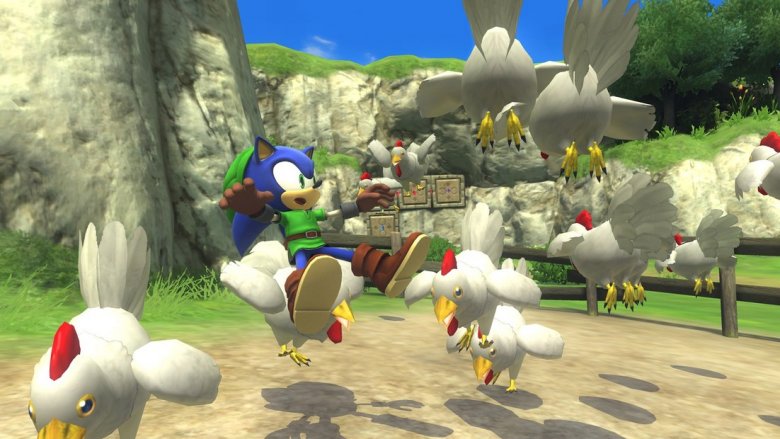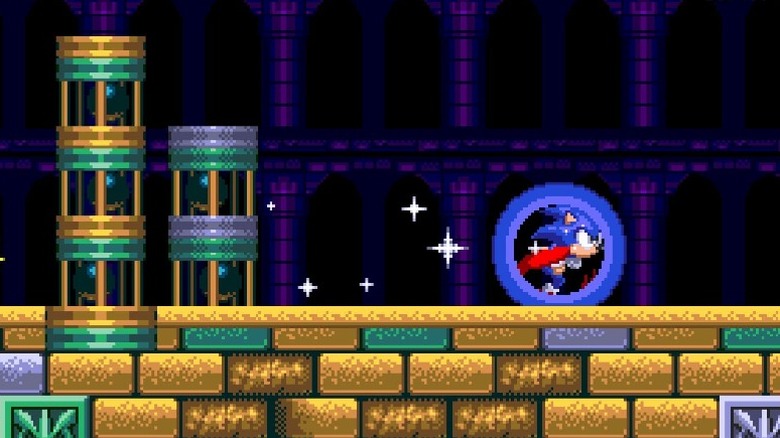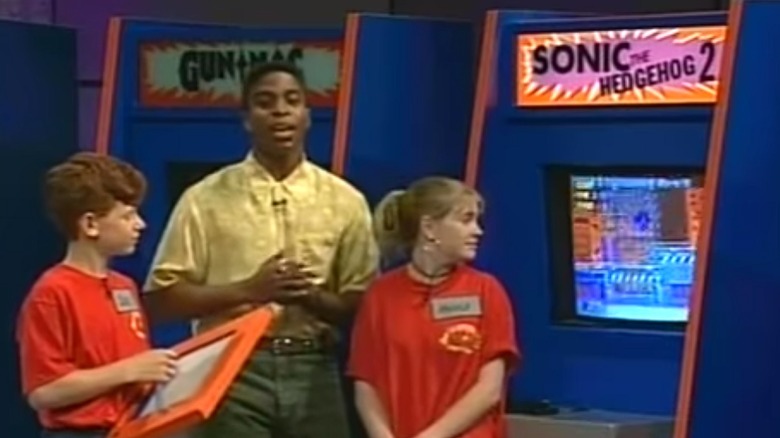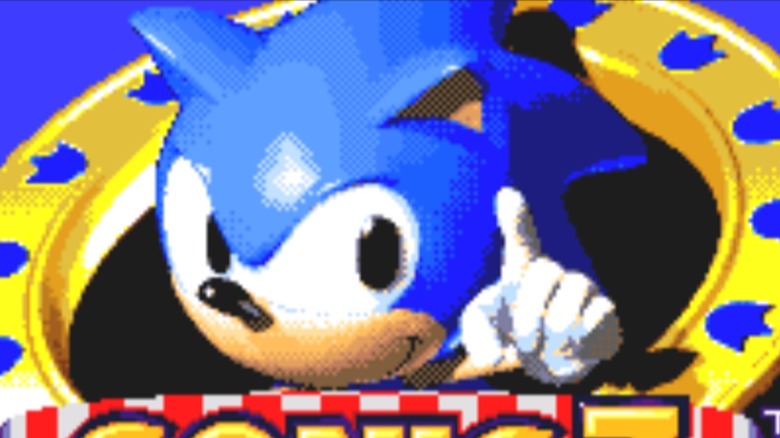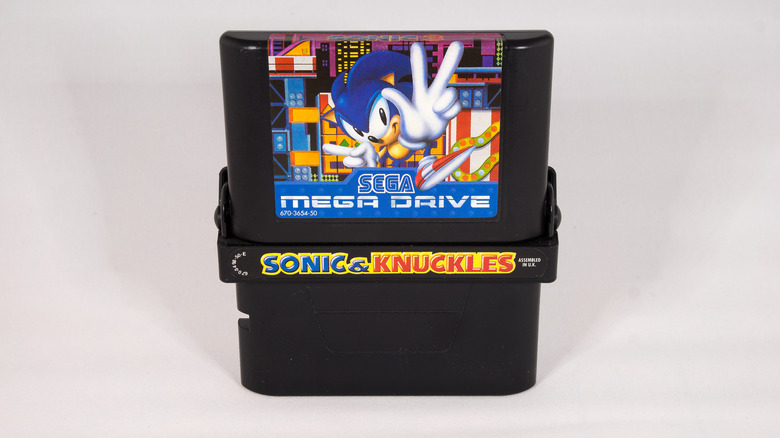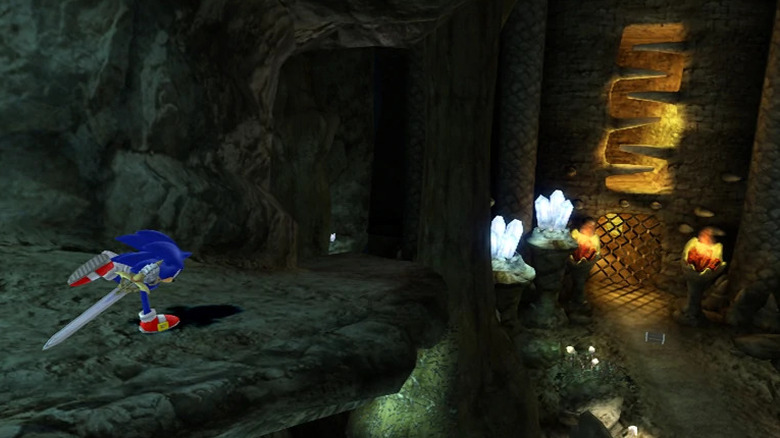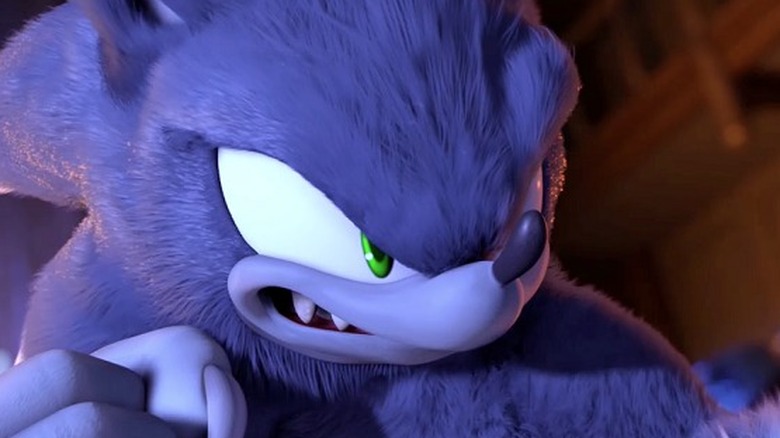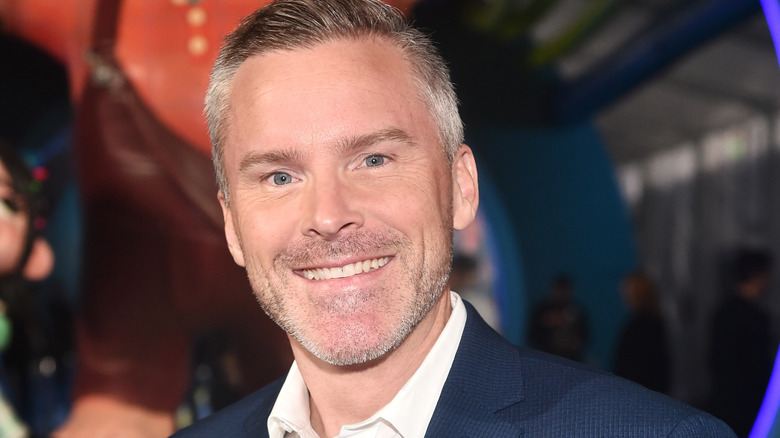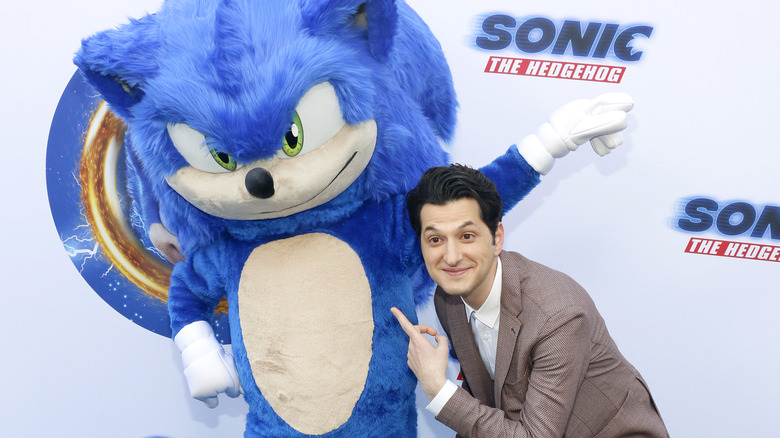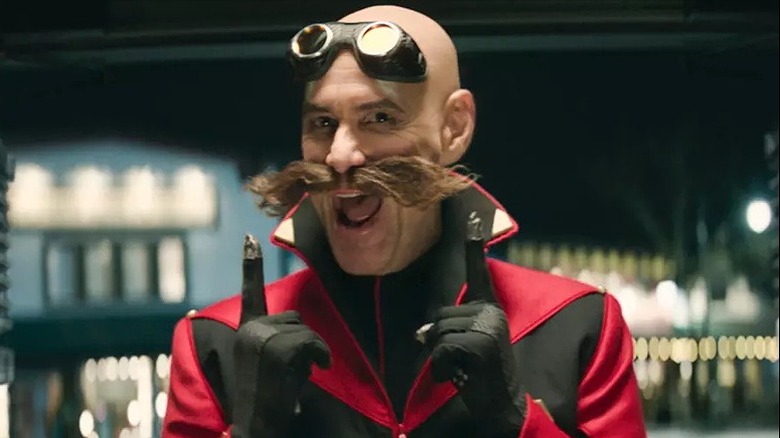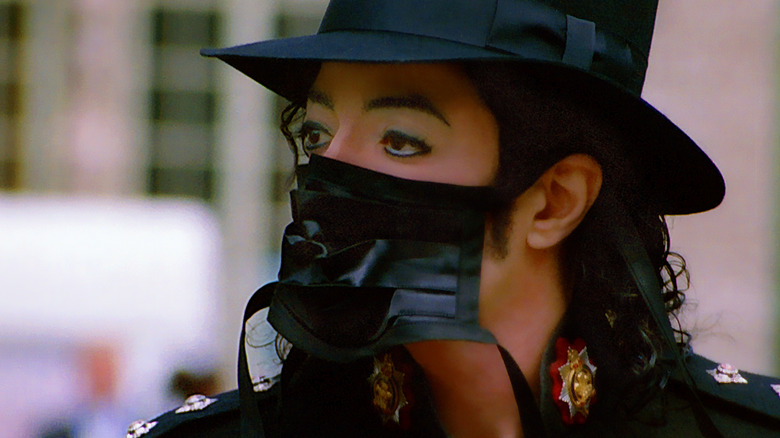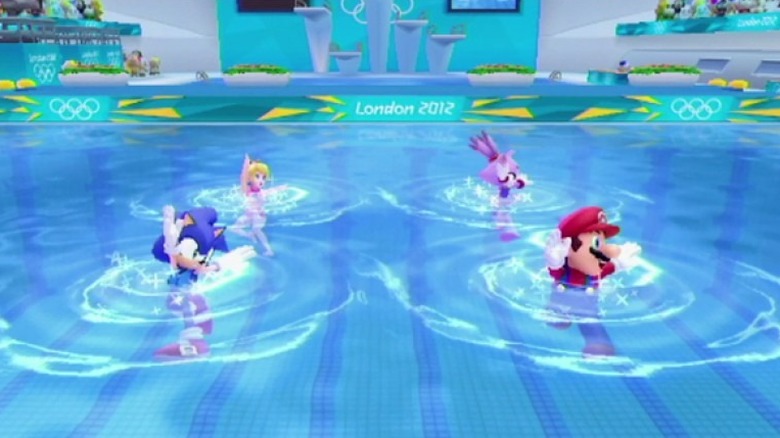The Untold Truth Of Sonic The Hedgehog
Rolling around at the speed of sound since 1991, the blue blur known as Sonic the Hedgehog has had countless adventures across multiple generations of gaming, some renowned as among the best games in the entire medium. But for as much of an icon as he's become, there are still well-kept secrets surrounding the fast-footed hedgehog, development diaries' worth of untold truths just waiting to be revealed.
Inquiring minds are desperate to know about the real stuff Sega has tried to sweep under the rug, as well as some fun new facts about their favorite gaming mascot. With that in mind, we've compiled the most intriguing nuggets of secret history from Sonic's past. Gotta go fast!
Random New Yorkers gave us Sonic (a.k.a. Mr. Needlemouse)
Every hero has got to start somewhere, and Sonic first hit the ground running alongside a handful of other bizarre characters. In a 2018 interview at the Game Developers Conference, "Sonic the Hedgehog" game designer Hirokazu Yasuhara and character designer Naoto Oshima talked about the process they went through to come up with Sonic. They knew they wanted their game's main character to be a creature that could roll up into a ball, but they couldn't settle on what kind of creature exactly. An armadillo, a porcupine, a hedgehog, a dog, and a mustachioed old man were all on the shortlist.
In the midst of debating what character would star in the game, Oshima had to take a trip to New York City. While he was there, he decided to take drawings of all the characters down to Central Park to ask random strangers what they thought of the designs. He explained, "The result was, the hedgehog was most popular; people pointed at it and really liked it." The old man was the runner-up, so Oshima and his coworkers eventually recycled that design into the character we now call Dr. Eggman.
Oh, and for a brief period of time, Sonic was known as "Mr. Needlemouse." Thankfully, that was another element that quickly changed during development.
Sonic once had a human girlfriend named Madonna
Just about everyone remembers Elise, the other human girlfriend Sonic had at one point, but nobody really associates Sonic the Hedgehog with human women. With that in mind, hearing about Sonic's first human girlfriend might come as a surprise. This particular significant other never left the drawing board for obvious reasons that were later forgotten about and ignored during development on "Sonic the Hedgehog" (2006), but it doesn't change the fact that, for a very short period of time, Sonic's canonical ladyfriend did exist.
Her name was Madonna and she was started dating the super cool Sonic because he was in a rock band. That's right, before Sonic the Hedgehog made his big solo debut in 1991, he was slated to be a rock star with a human girlfriend. Consider that one bullet dodged. At least for the next 15 years, anyway.
Sonic can't swim because of a misunderstanding
Any time Sonic goes underwater, it becomes one of the most stressful exercises in the franchise, with players scrambling to find air bubbles or reach the surface before their hero drowns. This is made all the more tense by the intensely escalating music, played over a countdown as Sonic exhausts his last gasps of air and tries to avoid a watery grave. As it turns out, the origins of Sonic's inability to swim all sprung from a misunderstanding on the part of "Sonic the Hedgehog" lead programmer Yuji Naka.
When developing the first game around Sega's planned mascot, Naka was under the assumption that hedgehogs were unable to swim and brought this thought to gameplay mechanics. Years later, Naka was surprised to learn that hedgehogs are indeed capable of swimming, albeit perhaps not as gracefully as other mammals in the animal kingdom. By then, however, it was already firmly established that Sonic was a character with leaden feet, sinking to the bottom of any water source like a rock and causing players to panic.
Sonic CD began development as a completely different game
By 1993, Sonic the Hedgehog was a bonafide gaming phenomenon, helping propel Sega to impressive heights worldwide as the company's marquee franchise. In order to extend the life cycle of the Sega Genesis and boost its processing power, Sega launched the Sega CD. To help promote this peripheral, Sega planned to launch a Sonic game for it, initially hoping to remaster a game to show off the technical upgrade before deciding to create an entirely new game instead.
Sega originally wanted to remaster the original 1991 "Sonic the Hedgehog" under the title "Super Sonic," with the project taking advantage of the Sega CD's capabilities to add new levels and cutscenes. As development on the project continued, the developers decided to make the game its own unique experience, retitling "Sonic CD," adding a time-travel mechanic and placing a heightened emphasis on exploration. The 1993 game fulfilled Sega's desire to give the Sega CD its own Sonic title, continuing the franchise's omnipresence.
Doctor Robotnik's Mean Bean Machine was an elaborate re-skin
The Sonic franchise has seen a whole line of spinoffs, but one of the strangest of them all is the 1993's "Doctor Robotnik's Mean Bean Machine" for the Genesis. The title is a puzzle game in which colored blocks steadily descend as two players attempt to complete more lines in combos, which in turn create blocks to overwhelm their opponent. A staple in subsequent Sonic compilations for modern consoles, the game was first released to Japanese audiences with a vastly different narrative premise in place.
The puzzle game that served as the basis for "Mean Bean Machine" was "Puyo Puyo," a game that in turn made use of characters and environments from the fantasy franchise "Mado Monogatari." To better appeal to North American audiences for its 1993 release, the game was released using the designs from the 1993 animated series "Adventures of Sonic the Hedgehog." Much of Compile's previous source code for "Puyo Puyo" is still present in "Mean Bean Machine's" programming, just hiding beneath the re-skinned characters.
Sonic the Hedgehog 2 was originally a time-travel story
Sega catapulted over the sales records set by the original 1991 "Sonic the Hedgehog" with its 1992 sequel, which featured more elaborate levels, a greater emphasis on speed, and the addition of Sonic's partner Tails. The game took Sonic from Oil Ocean to Mystic Cave Zones and way up into space as he raced to stop Doctor Robotnik's latest twisted plot. However, "Sonic the Hedgehog 2" initially was planned to have an ambitious time-travel premise, which may have seen Sonic ventured to both the past and future to combat Robotnik.
According to Hardcore Gaming 101's research, Casino and Chemical Plant Zones were intended to take place in a dystopian future, while Hill Top Zone was planned to take place in the past. The time-travel component was eventually dropped for "Sonic the Hedgehog 2," but played a prominent role in 1993's "Sonic CD."
Sonic Spinball was inspired by another game's delay
With "Sonic the Hedgehog 2" being such a tremendous success for Sega, internal expectations were running high for a sequel to come out on time and maintain the franchise's momentum. When it became clear that "Sonic the Hedgehog 3" could not effectively be completed in time for the 1993 holiday season, Sega of America decided a stop-gap title should be released in the interim. With a limited development window, Sega decided to proceed with a spinoff that became the pinball-themed "Sonic Spinball."
According to a SonicRetro interview with developer Peter Morawiec, the pinball concept for the game solidified when Sega's marketing department identified Casino Night Zone as being one of the more popular levels in "Sonic the Hedgehog 2." The Sega Technical Institute developed "Sonic Spinball" in approximately six months to meet its planned holiday season launch. While it was successful in coming out on schedule, the developers were overall dissatisfied by the final version's relative lack of polish.
Sonic R began development as a Formula 1 game
The only original Sonic the Hedgehog game released for the Sega Saturn was 1997's "Sonic R," a racing title that allowed players to control different Sonic characters through a variety of tracks. Though the gameplay shared many elements with contemporaries like "Mario Kart," it also placed a prominent focus on exploration as the characters set out to obtain the Chaos Emeralds. However, "Sonic R" began with a completely different premise entirely, with development on the project starting out as a Formula 1 racing game.
Traveller's Tales, the British developer that had previously made "Sonic 3D Blast," was approached by Sega to make a new Sonic title. The developers decided to repurpose its initial plans for a Formula 1 game, putting Sonic and other cute animals in place of the cars intended for the project. The original premise was also scaled back in a lot of ways due to time. Traveller's Tales completed the project in approximately nine months, releasing "Sonic R" in time for the 1997 holiday season. Sadly, the completed game only contained five tracks.
Sonic was supposed to have a bigger presence on the Sega Saturn
"Sonic R" wasn't intended to be the only new Sonic game released on the Sega Saturn. A more traditional platformer was once planned to herald a new era for the franchise on the console. "Sonic X-Treme" began development in late 1994 and was originally built to be a side-scrolling title like past "Sonic" games. However, as development continued, the project shifted to a 3D platformer and moved from the Sega 32X peripheral to the Saturn in 1995.
Programming a game with then-cutting edge 3D gameplay proved to be more challenging than the development team anticipated, and internal politics at Sega hindered the project. The troubled production and delays led to long working hours for the team, with programmer Chris Coffin even contracting walking pneumonia and designer Chris Senn similarly falling gravely ill. When faced with a demoralized and severely ailing team, Sega quietly pulled the plug on "Sonic X-Treme" in 1997, leaving the Saturn without its own mainline Sonic game.
Sonic Adventure inspired a modern redesign
While the Sonic franchise had ventured into 3D spaces before, the series made its full foray into 3D platforming with the flagship Sega Dreamcast title "Sonic Adventure" in 1998. The Dreamcast's tech allowed the development team to craft lush, immersive environments for Sonic to explore at breakneck speed. And since the team was working with significantly more powerful hardware, the developers decided to use the opportunity to redesign Sonic, creating the more modern iteration that fans are familiar with today.
Lead character designer Yuji Uekawa was in charge of developing Sonic's look in "Adventure," and looked to inspiration from Disney and Looney Tunes cartoons, as well as character work by "Dragon Ball" creator Akira Toriyama. Sonic's design was slimmed down from his previous models, while his arms and legs were extended to give the character a considerably lankier appearance. This redesign allowed Sonic to become more emotive in his movements and gave Sega's icon a look that would endure far longer than his original design.
Sonic 4 was meant to be longer
After years of expansive 3D platformers and action spin-offs, the Sonic franchise decided to go back to the basics with the 2010 game "Sonic the Hedgehog 4," returning to classic side-scrolling gameplay. Instead of a single title, the game was divided into a duo of episodes, concluding with 2012's "Sonic the Hedgehog 4: Episode 2." However, "Sonic the Hedgehog 4" was intended to be a trilogy of installments before producer Takashi Iizuka announced to Digital Spy that "Episode 2" would be the end for the foreseeable future.
In 2015, former Sega digital brand manager Ken Balough confirmed that there were indeed plans for "Sonic the Hedgehog 4: Episode 3," as evidenced by unused text alluding to a sequel being found in the game's code. Balough did not provide an exact reason for why "Episode 3" was quietly canceled by Sega, observing that a third episode would "likely never see the light of day" (per Gameranx). Player reception towards the first two chapters was mixed at best, though, which may be why Sonic's first big 2D return to form remains woefully incomplete years later.
DeviantArt helped inspire Sonic Forces
Google "your name + the hedgehog." Go on, we'll wait.
Wild, isn't it? Here's the scoop: the Sonic fanbase loves Sonic. Like, they're his fans, after all. It makes sense. Still, it's the extent to which they love him that separates this fanbase from others — so much that they've invented an entire catalog of anthropomorphic animals to match up with almost every first name in the western English language. These are all original characters, mind you, and where there are original characters, there is original art.
Where does one find this mountain of primarily American-youth-driven art, you might ask? A little California-based site called DeviantArt. This is, by sheer statistical probability, no doubt what Takashi Iizuka was referring to when he said "this whole understanding how American fans are interacting with the character was the seed" for "Sonic Forces," a game in which you make your own original character and live out OC fantasies to your heart's content. So, in a very real way, this is as much DeviantArt's game as it is Sonic Team's.
The Sonic Mania development team had to remake every '90s Sonic sprite
Thanks to impeccable design choices on the development team's part, "Sonic Mania" looks near-identical to the original Genesis trilogy, so much so that you'd be forgiven for mistaking it as a copy-and-pasted sprite sequel. The reality is anything but: these sorry fellows had to replicate everything you see by hand.
From the textures to the physics to the quirky and vibrant animations, absolutely everything you see is custom-(re)made for "Mania." That high-octane spiraling ascent Sonic launches into after hitting a spring might look identical to the one in "Sonic CD," but it sure wasn't lifted directly—every detail was painstakingly recreated by Christian Whitehead and his all-star development team in the service of cooking up a throwback game for the ages.
Lost World isn't the first time Sonic's encountered Hyrule
Back when "Sonic Lost World" was the franchise's hot new release, people could hardly fathom the DLC the game was touting. A "NiGHTS" level? No way. A "Yoshi's Woolly World" level? Too cool! But then, after no one thought it could get any better, the world collectively lost its mind when SEGA revealed that the final DLC level would be none other than a Hyrulian, "Legend of Zelda"-themed adventure.
People were blown away by the idea of Sonic's and Link's worlds crossing paths. Yet for all the excitement surrounding this expansion, they'd be remiss to declare this a groundbreaking event. See, Sonic and Link — heck, Sonic and Hyrule as a whole — have already met before. In the "Super Smash Bros. Brawl" dimension-hopping campaign mode Subspace Emissary, Sonic doesn't just meet Link and Zelda — he saves their lives. So, when you see him dashing around Hyrule and interacting with its denizens in "Lost World," remember, it's not the first time he's had to rescue them from dark forces.
In Sonic 3, you could actually go too fast
"Sonic the Hedgehog," also known as the brand that created such snappy phrases as "you're too slow" and "gotta go fast," is, as you might have guessed, all about speed. Blazing over vast stretches of land in the blink of an eye and breaking the sound barrier are just everyday occurrences for this hedgehog, leaving you to wonder: is there ever such a thing as "too fast?"
Believe it or not, there used to be. While Sonic can no longer out-speed his games, that wasn't the case in 1994. In "Sonic 3" specifically, some of the level geometry negatively reacted to Sonic's physics set and could, provided the right circumstances, result in speeds too rip-roaring for even the lightning-fast hedgehog to handle, which typically ended with him blazing through textures and bypassing portions of levels entirely. While this might sound like a nifty shortcut to be utilized by speedrunners, the reality is it could throw Sonic so far ahead of the layout that he'd often clip out of the level entirely and die instantly, or worse yet, end up somewhere game-breaking. The moral of this story: if you've got to go fast, be responsible about it.
An early version of Sonic 2 debuted in a surprising place
Sega followed up with the enormous success of the original "Sonic the Hedgehog" game with the 1992 sequel, the appropriately-named "Sonic the Hedgehog 2." The console version of the game released on November 21, 1992, but a few weeks before the console launch, an early build of "Sonic the Hedgehog 2" was among the featured games in the short-lived Nickelodeon competition show "Nick Arcade." This early version of the game was shown off in the show's final four episodes, with the television series concluding on November 6, 1992.
The prototype used for "Nick Arcade" was eventually shared online in 2006, allowing gamers to get a closer look at the build than the brief looks allowed on "Nick Arcade." Several assets from the original "Sonic the Hedgehog" (including music and graphics) were recycled in this version, and numerous glitches are present. With "Nick Arcade" currently available to stream in its entirety on Paramount+, Sonic fans can easily check out a rare version of "Sonic the Hedgehog 2" by pulling up its last stretch of episodes.
Sonic 3 and Sonic & Knuckles were meant to be one game
"Sonic 3" and "Sonic & Knuckles" are, technically speaking, two separate games. But what if we told you that they're actually one big game, both in concept and execution? Well, that was the original plan. Multiple factors led to the game being split in two, with the most crushing being the development team's deadline. Focusing efforts to craft the most ambitious "Sonic" game yet, the team wasn't prepared to meet Sega's strict deadlines, imposed in order to tie in with an unanticipated McDonald's promotion. That, coupled with the fact that the game's levels were larger and more plentiful, compounded the time issue while simultaneously leading to another roadblock: the game was becoming too big for Sega's cartridges at the time.
All this led the team to split "Sonic 3" in half, making the second portion of it, "Sonic & Knuckles," a separate game with the ability to lock onto the "Sonic 3" cartridge. This feature enabled the post-launch reunification of Sonic Team's original vision for "Sonic 3" and resulted in a happy ending for everyone involved: the team met their ambitious goal, Sega reaped the profits of two separate games, and the fans got to experience everything the developers had originally intended.
Sonic & Knuckles is the only game to have the Genesis's lock-on technology
As cool as it is that "Sonic 3" and "Sonic & Knuckles" were originally supposed to be one game, what made it much, much cooler is that an entirely unique technology was developed in-house at Sega in order for Sonic Team to reunite the two halves of their one-big-game vision post-launch. An ambitious technological advance for gaming in 1994, lock-on technology worked by combining multiple ROM chips into a single address space, essentially tricking the Genesis into thinking that only one large cartridge was plugged in.
It was a brilliant way to circumvent hardware limitations of the time and led to some pretty cool Easter eggs. Not only could you plug "Sonic & Knuckles" into "Sonic 3" in order to get the fully intended experience out of both, but you could also plug it into Sonic 2 to unlock Knuckles as a playable character. And, were you bold enough to plug "Sonic & Knuckles" into any other cartridges released for the Sega Genesis, you'd get a ton of playable blue sphere levels, also known as the special stages from "Sonic 3 & Knuckles."
The wildest part? This cool technology was made for the company's flagship franchise and never seen again, meaning "Sonic & Knuckles" remains the only lock-on game to ever be made for the Sega Genesis.
The Sonic Storybook series was intended to have a third game
Over the years and between various mainline entries, Sega sought to find ways to take its flagship property into more creative directions with its spinoff titles. One of the more off-kilter spinoff series launched in 2007 and was branded by Sega as the "Sonic Storybook" series due to its literary inspirations. Starting with "Sonic and the Secret Rings" on the Nintendo Wii, the spinoff series came to a quiet end in 2009 with "Sonic and the Black Knight," also released for the Wii.
Although no other titles in the storybook series were unveiled to the public, there were early plans for the spinoff line to be a full trilogy. Weeks after "Black Knight” launched, Sega conducted a public poll to gauge which genre fans would want a third storybook game to be set in. This was followed by a 2011 presentation by Sega Mexico, during which a company representative also alluded to plans for a follow-up to "Black Knight." Ultimately, the project was shelved entirely and both storybook games were quietly delisted from retailers by Sega.
Even iconic horror directors love Sonic
As one of the most recognizable video game franchises of all-time and boasting decades' worth of titles, "Sonic the Hedgehog" has acquired many notable fans across its history. One of the most surprising of all is legendary filmmaker John Carpenter, a self-professed fan of the franchise since the '90s. Initially buying the game for his young son, Carpenter found himself drawn to playing the game himself and especially appreciated its vibrantly engaging musical score.
Although frustrated by the games' difficulty and occasional lack of saves, especially in the underwater levels, Carpenter continues to be a longtime fan of the series. Decades later, Carpenter still keeps up with "Sonic the Hedgehog" games and even enjoys some of the more critically divisive titles in the franchise, including "Sonic Unleashed." And for being the visionary behind horror classics like "Halloween" and "The Thing," perhaps Carpenter's appreciation of the werewolf-themed 2008 entry makes total sense.
Fans rallied to save Sonic's voice
Ever since 2010's Xbox 360 racing game "Sonic Free Riders," the blue speedster has been voiced many times by prolific actor Roger Craig Smith, who animation fans might recognize for other heroic roles such as Captain America and Batman. Across a myriad of games and the 2014 animated series "Sonic Boom," Smith became a favorite among fans for his performances as the character. And though Craig initially announced plans to leave the role in 2021, leaving Sonic without a voice in his console adventures, fan support what kept him in the role for the foreseeable future.
After Craig tweeted his intention to leave the "Sonic the Hedgehog" franchise to pursue other career opportunities, fans rallied online, voicing their hopes that Craig would remain in the role. Shortly thereafter, Craig tweeted a response, thanking the fans for their support and confirming he would continue to voice Sonic in future projects featuring the character. The full circumstances behind Craig's intended departure are still unknown, but the vocal fan support seems to have played a major role in reversing the decision.
Ben Schwartz wasn't Hollywood's first choice to voice Sonic
After starring in two acclaimed video game adaptations, Ben Schwartz has been praised for his performance in bringing the beloved icon to cinematic life. However, while Schwartz has since received rave reviews for his role, he was not among the initial round of actors considered for the part by Paramount Pictures. An alleged internal casting shortlist from 2017 was leaked to the public in 2018 for Sonic and his human friend in the film, Sheriff Tom Wachowski, who was ultimately played by actor James Marsden.
Schwartz and Marsden were glaringly absent from the original shortlist for either role, while several interesting alternates are included in the lineup. Among the most notable suggestions for Sonic were Tom Holland and Chris Pratt, both of whom would go on to star in different video game adaptations ("Uncharted" and "Super Mario Bros.," respectively). Fortunately, judging by Schwartz and Marsden's performances, it just goes to show that first picks for a role aren't always the perfect fit.
Jim Carrey fell in love with being Eggman
Some Sonic fans had to warm up to the idea of Ben Schwartz voicing their beloved hero, but Jim Carrey as Robotnik/Eggman was an easier sell. Dr. Robotnik is an over-the-top evil mastermind, but he's also deeply goofy while still managing to have some depth as a character. It's hard to imagine anyone who could personify that mixture better than Carrey, and after getting to see him in multiple movies, fans of the franchise have really come to love his take on the villain.
It seems like no one enjoys Carrey's Eggman more than Carrey himself. The actor fully embraced the video game goofiness in the first "Sonic" movie, but it seems like the sequel is what really sold him on the character. "I think he's just so much fun," Carrey told GAMINGbible in 2022, "and he's evolving, you know, that's the good thing about him — he didn't just stay one way."
After appearing in "Sonic the Hedgehog 2," Carrey announced that he planned to retire from acting. He told Access Hollywood that there's only one way he'd make another film: "If the angels bring some sort of script that's written in gold ink that says to me that it's going to be really important for people to see." Either "Sonic 3" was that heavenly script, or Carrey just can't get enough of Eggman. Either way, he came out of his planned retirement to help the "Sonic" movies become a trilogy.
Sonic the Hedgehog 3 has a murky connection to Michael Jackson
One of the biggest mysteries surrounding the entire Sonic franchise is whether or not the King of Pop himself, Michael Jackson, contributed to tracks for the "Sonic the Hedgehog 3" soundtrack. According to rumors and online speculation, Sega worked with Jackson to compose a soundtrack only to ultimately scrap his contributions after the pop star faced abuse allegations in 1993. Jackson's tour director Brad Buxer echoed that Jackson contributed tracks to the "Sonic the Hedgehog 3" soundtrack, but was unsure if any of his work remained in the finished game (per HuffPost).
Sega's leadership has publicly refused to directly comment on the matter of any involvement from Jackson to the video game series. In 2022, the original game's lead programmer, Yuji Naka, appeared to allude to Jackson contributing to the "Sonic the Hedgehog 3" soundtrack, but later backtracked these comments, citing a translation error on Twitter. While the extent of Jackson's involvement with the Sonic franchise, if there was any direct involvement at all, remains an mystery, it has built up a gaming legend of its own that has lasted for years.
There is one article of clothing Sonic must wear at all times
After Sega pulled out of the console wars following the relative failure of the Dreamcast, the company began a prosperous partnership with Nintendo. In addition to a new era of Sonic games being released on Nintendo consoles, Sonic and Nintendo's Mario would team up for a series of sports-related crossover titles. During production of "Mario & Sonic at the 2012 Olympic Games" for the Wii, the developers received an interesting note about how Sonic should be depicted.
Sega Sports R&D and Racjin designed swimwear for each of the playable characters in the 2011 sporting crossover game to accommodate water sports. Director Eigo Kasahara revealed (per Shacknews) that Sega insisted that Sonic never remove his signature shoes, even when participating in aquatic activities, favoring his usual iconic fashion over practical function. There is yet to be any definitive word whether or not Sonic is allowed to remove his white gloves and expose his bare hands.

